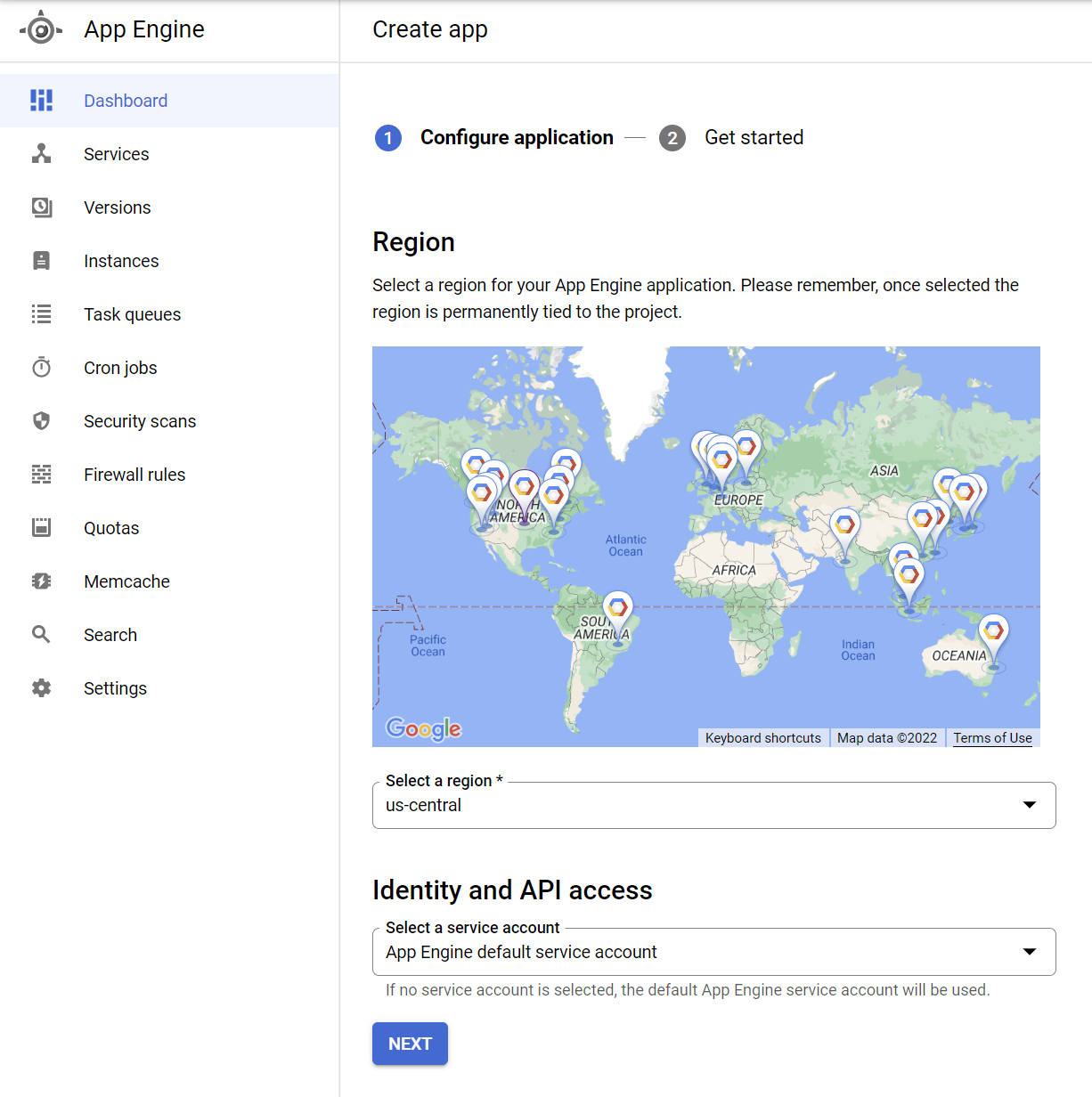Home / GCP / GCP Training / Worked Example - Deploy An Application Using App Engine
1. Create an App
 |
2. Create Service
Open a cloud shell.
Create a directory for the service: mkdir service-1
Within the directory, create 3 files:
app.yaml (Application configuration)
runtime: python39
main.py (Python service)
from flask import Flask
app = Flask(__name__)
@app.route('/')
def hello():
return 'App Service 1 - VERSION 1'
requirements.txt (Python dependencies)
Flask==2.0.2
3. Deploy Service
# Set the project
> gcloud projects list
PROJECT_ID: app-eng-mjn
NAME: app-eng-mjn
PROJECT_NUMBER: 999908460627
PROJECT_ID: lustrous-method-999999
NAME: My First Project
PROJECT_NUMBER: 999956012473
> gcloud config set project app-eng-mjn
Updated property [core/project].
# Deploy the app
> gcloud app deploy
descriptor: [/home/mjnlearnsgcp/service-1/app.yaml]
source: [/home/mjnlearnsgcp/service-1]
target project: [app-eng-mjn]
target service: [default]
target version: [20221223t145157]
target url: [https://app-eng-mjn.uc.r.appspot.com]
target service account: [App Engine default service account]
Do you want to continue (Y/n)? y
Beginning deployment of service [default]...
Created .gcloudignore file. See `gcloud topic gcloudignore` for details.
Uploading 3 files to Google Cloud Storage
33%
67%
100%
File upload done.
Updating service [default]...done.
Setting traffic split for service [default]...done.
Deployed service [default] to [https://app-eng-mjn.uc.r.appspot.com]
Navigate to the URL: https://app-eng-mjn.uc.r.appspot.com
Browser will display App Service 1 - VERSION 1
Check what’s deployed.
> gcloud app services list
SERVICE: default
NUM_VERSIONS: 1
> gcloud app versions list
SERVICE: default
VERSION.ID: 20221223t145157
TRAFFIC_SPLIT: 1.00
LAST_DEPLOYED: 2022-12-23T14:54:20+00:00
SERVING_STATUS: SERVING
> gcloud app instances list
SERVICE: default
VERSION: 20221223t145157
ID: 00c61b117ca953b7c54044eebe54eb87956b42bc1dc01cd9ab84dd5e80120b1a60533e859332fd1bcc4a4a3c5686eba83811d058d42673253d6b
VM_STATUS: N/A
VM_LIVENESS:
DEBUG_MODE:
4. Deploy A Second Version Of The Service
Edit file: main.py
from flask import Flask
app = Flask(__name__)
@app.route('/')
def hello():
return 'App Service 1 - VERSION 2'
Deploy version 2. Name the version this time.
> gcloud app deploy --version=v2
> gcloud app list versions
SERVICE: default
VERSION.ID: 20221223t145157
TRAFFIC_SPLIT: 0.00
LAST_DEPLOYED: 2022-12-23T14:54:20+00:00
SERVING_STATUS: SERVING
SERVICE: default
VERSION.ID: v2
TRAFFIC_SPLIT: 1.00
LAST_DEPLOYED: 2022-12-23T15:07:33+00:00
SERVING_STATUS: SERVING
Navigate to the URL: https://app-eng-mjn.uc.r.appspot.com
Browser will display App Service 1 - VERSION 2
Note: By default the URL now routes to the latest version however can still got to VERSION 1 using: https://20221223t145157-dot-app-eng-mjn.uc.r.appspot.com
(The version number assigned by default is datetime)
5. Split Traffic Between Version
Update main.py to display App Service 1 - VERSION 3.
Deploy new version BUT don’t make this active.
> gcloud app deploy --version=v3 --no-promote
Split traffic between v2 and v3.
> gcloud app services set-traffic --splits=v2=.8,v3=.2A --split-by=random
Setting the following traffic allocation:
- app-eng-mjn/default/v2: 0.8
- app-eng-mjn/default/v3: 0.2
NOTE: Splitting traffic by random.
Any other versions of the specified service will receive zero traffic.
Do you want to continue (Y/n)? y
Setting traffic split for service [default]...done.
Note: By default split will be by IP (the IP address of the requester - the browser).
Navigate to the URL: https://app-eng-mjn.uc.r.appspot.com
Browser will display version 2 and version 3 randomly in the split ration specified.
6. Naming A Service
To name a service, add the service name to the app.yaml
runtime: python39
service: mjn-service
This page was generated by GitHub Pages. Page last modified: 22/12/23 16:02